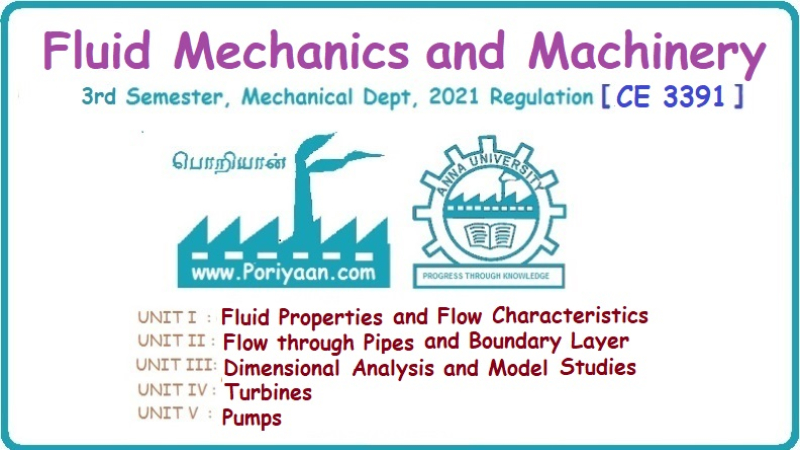Fluid Mechanics and Machinery: Unit 1: Fluid Properties and Flow Characteristics
Flow Characteristics
Fluid Mechanics
This topic deals with the properties of a fluid in motion. There are different types of fluid flow.
FLOW CHARACTERISTICS This topic deals with the properties of a fluid in motion. There are different types of fluid flow. The study of fluid flow is divided into Hydrostatics, Hydro kinematics and Hydrodynamics. Hydrostatics deals with liquid at rest. The kinematics of fluid in motion deals only with space-time relationships (velocity and acceleration) without taking in to consideration, the force or energy causing the flow. The fluid motion can be described completely by an expression describing the location of a fluid particle in space at different times, thus enabling determination of the magnitude and direction of velocity and acceleration in the flow field at any instant of time. Hydrodynamics of fluid is the study of fluid motion with the forces causing its flow. The dynamic behavior of the fluid flow is analyzed by the Newton's second law of motion, which relates the acceleration with the forces. Flow characteristics are studied by using two methods. (i) Lagrangian Method (ii) Eulerian method (i) Lagrangian method: A single fluid particle taken in to consideration and it is analyzed and followed to study its properties like velocity, acceleration, density, etc. (ii) Eulerian method: A particular space or region may be selected and fluid flows through this region. During this time, the fluid characteristics are analyzed. It is commonly used method. The fluid characteristics such as pressure, velocity, density, viscosity, temperature etc., may change from section to section in a pipeline and also with respect to time. The type of flow depends upon the conditions of fluid flow and it may be mainly classified into (i) Laminar flow (ii) Turbulent flow (iii) Steady flow (iv) Unsteady flow (v) Uniform flow (vi) Non uniform flow (vii) Compressible flow (viii) Incompressible flow 1. Laminar flow It is a smooth and regular flow. In this flow the fluid particles moves in layers, with one layer sliding over other. Each liquid particle has a definite path and the paths of individual particles do not cross with each other. This type of flow is also called as stream lined flow as shown in figure 1.13. The condition for this type of flow is (i) Low velocity of flow (ii) Flowing fluid is highly viscous (iii) Reynolds number is less than 2000. (iv) The flow is through a very narrow passage. Example: 1. High viscous oil moves slowly in a very small pipe 2. Smoke at the outlet of the chimney 2. Turbulent flow In this type of flow, the velocity of a particle will vary in magnitude and direction from point to point and time to time. Fluid particles will occupy different relative positions at different points. A flow in which each liquid particle does not have a definite path and moves in an irregular way is called turbulent flow as shown in figure 1.14. The individual path of each particle crosses each other there by forming eddy currents. Hence sometime this type of flow is also called as eddy flow. The condition for this type of flow is (i) Very high velocity of flow. (ii) Reynolds number is greater than 2000. (iii) The particles in one layer collide with particles in another layer. Example: 1. Discharge of smoke in atmosphere. 2. Flow in rivers during floods. 3. Flow of water in the pump. 4. Waterfalls. 3. Steady flow When the fluid properties such as velocity, density, pressure, temperature and discharge etc., at any point in the pipe remains constant that the flow is said to be steady flow. Example: flow through a tap, when the water level in a tank is constant 4. Unsteady flow When any one of the properties of the fluid at any point varies with respect to time, then the flow is said to be unsteady flow. Example: flow through a tap, when the head is not constant. 5. Uniform flow If the magnitude and direction of velocity at a point of liquid in motion don't vary with respect to time then the flow is said to be uniform flow. Example: flow of fluids through a pipe line or over channels, whose cross sectional area is constant. 6. Non uniform flow The motion of a fluid is said to be non uniform when velocity changes from point to point on its flow. Example: flow through a taper pipe. 7. Compressible flow In this flow, density of fluid is same at all sections. Example: liquid flow in pipes. 8. Incompressible flow In this flow, density of flow is not same at all section. Examples: gas flow in pipes 9. Rotational flow It is a flow in which the fluid particles also rotate about their own axis while flowing along stream line. 10. Ir-rotationalflow It is a flow in which fluid particles do not rotate about their own axis while flowing along the streamlines. 11. One dimensional flow It is a flow in which the velocity of the flow is a function of time and one space coordinate (x (or) y (or) z). The flow through a pipe is one-dimensional flow. 12. Two dimensional flow It is a flow in which the velocity of the flow is a function of time and two space coordinate (xy, xz or yz). The flow between two parallel plates of large extent, flow over a long spill way is an example of two dimensional flow 13. Three dimensional flow It is a flow in which the velocity of the flow is a function of three space coordinates (xyz) and time. Flow in converging or diverging pipe section is a three dimensional flow. Types of flow lines The following types of flow lines are there during the movement of fluid i) Path line: A path line is a curve traced by a single fluid particle during its motion. Thus the path line shows the direction of a fluid particle for a certain period of time as shown in figure 1.15. ii) Stream line: A stream line is an imaginary line drawn in the fluid in such a manner that the velocity of the fluid at each and every point on the stream line is tangent to stream line as shown in figure 1.16. iii) Stream tube: The stream tube consists of stream lines forming its boundary surfaces. The stream tube is defined as a circular space formed by the collection of stream lines passing through the perimeter of a closed curve in a steady flow as stream tube is bounded on all sides by stream lines. Therefore no fluid can enter or leave the stream tube from the sides except from the ends as shown in figure 1.17. iv) Streak line : It is an instantaneous picture of the positions of all fluid particles in the flow which have passed or emerged from a given point. The line of smoke from a cigarette or from a chimney is nothing but a streak line or filament line. v) Potential line: The lines of equal velocity potential are called potential lines. These potential lines cut stream lines orthogonally i.e. a stream line and a potential are at right angle to each other. It is defined as the rate of displacement. In other words, it is the distance moved by fluid particle in unit time. Velocity = Distance moved/Time It is represented by V and its unit is meter per second. 1. Mean velocity of flow In the actual flow pattern of a fluid, the velocity of layers nearer to the boundary of the pipe is lower than that at the center of the pipe. The velocity off the fluid is maximum at the center of the pipe (As shown in figure1.18). For solving problems, a constant velocity which is equal to the average of the actual velocities over the whole cross section are of the pipe is considered. This average velocity with which the flow is taking place is known as mean velocity of flow. 2. Discharge or rate of flow The volume of liquid flowing per second is known as discharge. It is denote by the letter Q. Consider a liquid flowing through a pipe. Let A = area of the pipe V = velocity of flow When a volume of liquid in the shape of cylinder of length L will come out from the pipe in one second. Discharge = volume of cylinder = area × velocity Q = A × V (Unit of discharge will be in m3/s)Introduction:
1. Hydrostatics:
2. Hydro kinematics:
3. Hydrodynamics:
4. Types of fluid flow
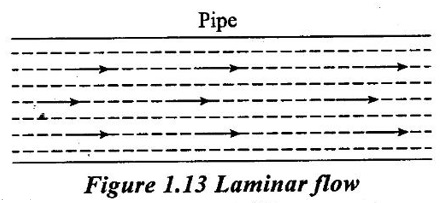

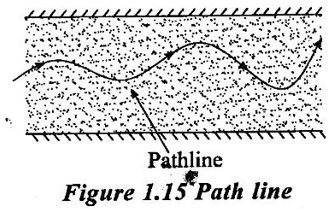

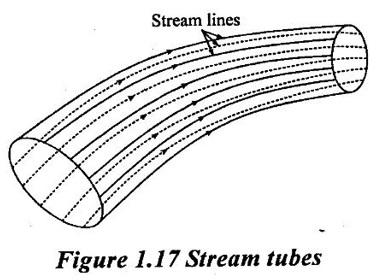
5. Velocity of flow
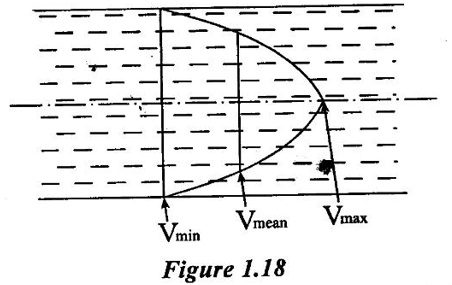
Fluid Mechanics and Machinery: Unit 1: Fluid Properties and Flow Characteristics : Tag: : Fluid Mechanics - Flow Characteristics
Related Topics
Related Subjects
Fluid Mechanics and Machinery
CE3391 3rd semester Mechanical Dept | 2021 Regulation | 3rd Semester Mechanical Dept 2021 Regulation
